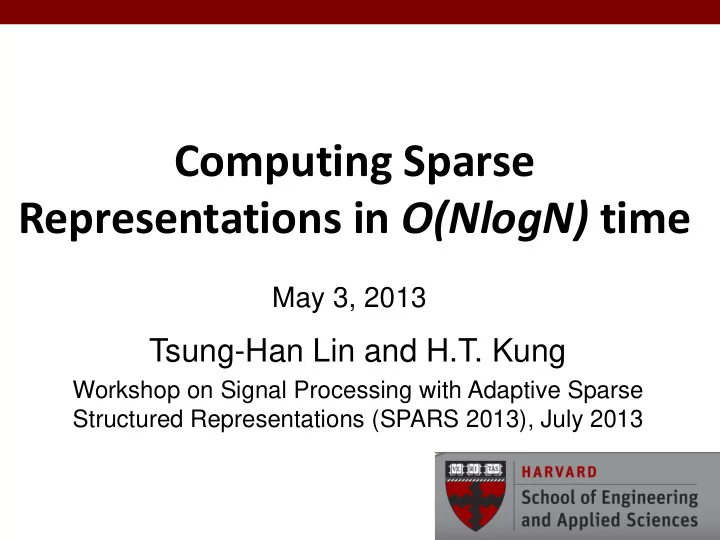

Computing Sparse Representations in O(NlogN) time May 3, 2013 Tsung-Han Lin and H.T. Kung Workshop on Signal Processing with Adaptive Sparse Structured Representations (SPARS 2013), July 2013
Hierarchical Feature Extraction • Deep learning – Stack multiple feature extraction layers in hierarchy – Layer 1: find sparse representations of image patches – Layer 2: find sparse representations of layer-1 output Coding Pooling Coding Pooling [Yu 2012]
Computation Cost at a Feature Extraction Layer • Complexity is O ( mn ) – mx1 input signal x and nx1 sparse code z • m depends on the output code length in the previous layer, can be large in deeper layer • n depends on dictionary size, governed by the machine learning task m = x D n z
Move Computations to Compressed Domain, i.e., Reducing m Layer 1 Layer 2 Sparse Sparse Feature Signal vector Coding Coding Layer 1 Layer 2 Sparse Sparse Feature Signal vector Coding Coding Compressed Compressed domain domain
How Much Can We Compress? Compression by random projections make dictionary atoms less distinguishable Compression ratio depends on the machine learning task, i.e., the dictionary size n Theorem. For a dictionary D that has n atoms, the input signal length m can be reduced to as small as O(log n/e 2 ) , as long as D is sufficiently incoherent, or, the coherence u of the dictionary satisfies: u < 1/(2K-1) – e where e is a small positive number and K is the sparsity.
Experiments on Object Recognition Recognition accuracy and run time No compression 2x compression 10x compression D: 2268 x 1000 D: 1134 x 1000 D: 226 x 1000 59.9% 59.3% 56.7% 75.4 sec 40.3 sec 8.0 sec • Two-layer sparse coding, compress second layer dictionary • Test on Caltech-101, 101 object classes, 2945 images
Conclusion and Future Work • The computations of deep learning can be performed in a low dimensional space • Savings in # operations, meaning savings in energy and time • Future work – Learning in the compressed domain – Novelty detection (afternoon)
Recommend
More recommend